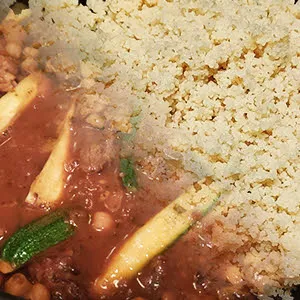Published:
Author: Antonio Maria Guerra
Couscous
Couscous is generally considered the Arab gastronomic specialty par excellence. There are no doubts about its deep connection with the desert and its people: those Berber nomads who in ancient times invented a kind of food that was easy to transport and quick to cook. Let’s find out its history, its preparation, as well as a large amount of information and curiosities. Enjoy the reading!

What is Couscous?
Couscous is a kind of food whose origins are lost in time, most likely born in the north-western portion of the African continent. In its most traditional form, it consists of durum wheat semolina, produced by coarse grinding the cereal more or less finely. Just like rice, Couscous is a staple food, used in a large number of recipes, both sweet and savory. The most classic requires it to be steamed and accompanied by a spiced stew of meat and vegetables (by extension, also this particular preparation is known as ‘Couscous’).

Maghreb: the cradle of Couscous.
The ‘Maghreb’, the north-western portion of the African continent that includes the great Sahara desert, is considered the place of origin of Couscous.


The history of Couscous.
Establishing with precision the origins of Couscous is not an easy task: many scholars trace them back to an indefinite period between the eleventh and thirteenth centuries (*1), in an area corresponding to the north-western portion of the African continent, between Mauritania and Tunisia. Other experts argue that they could be antecedent, locating them further south, in the sub-Saharan territories of Niger, Mali, Burkina Faso and Ghana. Finally, some historians hypothesize that the specialty was born in the Classical era, if not earlier (*2), in the Berber kingdom of Numidia (*3).
Being a poor food, easy to store, carry and prepare, for many centuries Couscous was the perfect tool to feed nomadic people and merchants
Read more
Not surprisingly, thanks to trade routes, it soon spread to many of the countries of the Mediterranean basin (and more): France, Sicily and the Iberian Peninsula above all.
The oldest written records referring to the specialty date back to the 13th century and come right from Spain, at the time under Arab rule (*4).
Notes:
*1: It’s the historical period that begins with the fall of the Berber dynasty of the Zirids (approx. 1049 AD) and continues with the rise to power of the Almohads;
*2: These conjectures are due to the discovery of tools suitable for the preparation of Couscous inside sepulchral complexes dating back to that time;
*3: ‘Numidia’ was the name of the region that included the territories between nowadays Morocco and Tunisia. In Roman times it became an imperial province;
*4: It’s important to remember that the Muslim domination over the Iberian peninsula lasted eight centuries: from the eighth to the fifteenth;

The ‘Couscousière’.
The tool generally used by North Africans to make Couscous is known as ‘couscousière’ (‘Couscoussier’ in French, ‘Taseksut’ in Berber, ‘Kiskas’ in Arabic): it’s a particular type of pot (*1),
Read more
consisting of a rounded base, in which the meat and/or vegetable stew is made, and a smaller container placed above, with a pierced bottom so that the vapors (rich in aromas) coming from below, steam the Couscous inside of it.
Note:
*1: The pot is often made of metal, but it can also be made of terracotta;


Couscous in the legend.
According to legend, King Solomon, son of David and ruler of Israel, fell madly in love with the Queen of Sheba visiting the court: a sentiment so deep that he completely lost his appetite, compromising his health and ability to govern.
Read more
His cook was so good to invent a dish, Couscous, so rich in spices to make him hungry again, thus saving his life.
Although both Solomon and the Queen of Sheba have a prominent place in the Bible, no credit should be given to this story: little more than a fable, full of undeniable charm.

‘Semolina’ for Couscous.
‘Couscous’, in its most classic form, consists of durum wheat semolina, which is the product of the grinding of the cereal. This grinding may vary, directly affecting the size of the grains: it’s therefore possible to find more or less fine Couscous on the market, suitable for different types of preparations.

The origins of the name ‘Couscous’.
It’s quite possible that the origins of the name ‘Couscous’, as well as those of the specialty, are Berber. The word could, in fact, derive from the Arabic ‘kuskus’ (‘kuskusu’) or, more likely, from ‘keskes’ …
Read more
… a word used still today to indicate the typical ‘layered’ pot commonly known in France as ‘Couscoussierre’.
It’s important to remember that this particular type of food, mainly thanks to its great practicality and versatility, was quickly adopted by many countries, taking in each one different names. Let’s review some of the most similar:
- ‘Couscous’, in France;
- ‘Kouskousaki’, in Greece;
- ‘Couscousu’, in Sicily (Italy);
- ‘Cascà’, in Sardinia (Italy);
- ‘Cuscuz’, in Brazil;
- ‘Wusu-Wusu’, in Togo, Senegal, Nigeria, Ghana and Benin;

How Couscous is made? (hints)
Before (briefly) illustrating the classic recipe for Couscous, it’s important to stress the fact that the name is generally used to indicate both the product, based on durum wheat semolina, and the dish, prepared with this semolina. Although the product requires a fair amount of time to be made (*1), once its granules are properly dried (*2), they can be preserved for long and cooked quite quickly.
Read more
This last feature has always been of fundamental importance since the specialty was invented as a poor and, especially, practical food, ideal for feeding the Berber nomads and the merchants who once (and, in part, still today), crossed the arid desert sands. All people without time for cooking.
 1) The most traditional Couscous is steamed in the ‘Couscoussierre’: a rounded pot used to cook a stew of vegetables and meat, whose vapors, passing through a pierced cover, slowly rehydrate the semolina. Today industrial Couscous is generally considered more practical since it just needs the addition of boiling water or broth;
1) The most traditional Couscous is steamed in the ‘Couscoussierre’: a rounded pot used to cook a stew of vegetables and meat, whose vapors, passing through a pierced cover, slowly rehydrate the semolina. Today industrial Couscous is generally considered more practical since it just needs the addition of boiling water or broth;
2) Once Couscous has become sufficiently light and soft, it’s good practice shelling it with a fork;
3) Couscous is generally placed in a serving dish, garnished with the stew, often (but not necessarily) aesthetically arranged;
In some Maghreb countries (Morocco, Tunisia and Algeria above all), the stew for Couscous is generally prepared with a combination of the following ingredients:
- Meat: lamb, chicken, mutton, sometimes camel;
- Vegetables: zucchini, carrots, onions, turnips, aubergines, raisins, parsley;
- Legumes: chickpeas;;
- Spices: saffron, coriander, spicy paprika, red pepper;
In some areas is used fish too;
Notes:
*1: Women generally had the task of processing the durum wheat semolina to make Couscous. This semolina, once sprinkled with water, was hand-worked and sieved to keep the larger grains, which make up the product;
*2: Not surprisingly, the preparation of Couscous necessarily requires its rehydration, traditionally carried out by steaming the semolina;

Not only wheat …
Although ‘Couscous’, in its most classic form, is produced by coarse grinding durum wheat (Triticum durum), there are variants made using the semolina from other cereals, such as millet, barley, and sorghum.

The African variations of Couscous.
Thanks to commercial traffic and cultural contamination due, among other things, to territorial conquests, Couscous, the specialty born in the north-western portion of Africa, soon spread to many other countries of the continent (and beyond). In each of these places, its original recipe was differently revisited, using typical local ingredients to enrich it with new flavors. A lot of variants developed: here follow some of the most famous:
Read more
Morocco: Moroccan Couscous is often considered the most classic.
Moroccan Couscous is often considered the most classic.
It’s generally made with lamb meat, accompanied by vegetables (turnips, tomatoes, peppers, carrots, fresh coriander, garlic, and onions) and flavored with many spices (cinnamon, coriander, paprika, ginger, black pepper, and saffron above all).
Algeria: The sauce used to accompany Couscous in Algeria is made with lamb and/or chicken (sometimes beef), vegetables (turnips, potatoes, tomatoes, courgettes, carrots, onions), legumes (chickpeas and/or beans ), and various spices (chili, cinnamon, coriander, cardamom, pepper, cloves, ginger, and cumin). Sometimes, especially in the areas near the coast, fish is used instead of meat.
The sauce used to accompany Couscous in Algeria is made with lamb and/or chicken (sometimes beef), vegetables (turnips, potatoes, tomatoes, courgettes, carrots, onions), legumes (chickpeas and/or beans ), and various spices (chili, cinnamon, coriander, cardamom, pepper, cloves, ginger, and cumin). Sometimes, especially in the areas near the coast, fish is used instead of meat.
Tunisia: In Tunisia, in addition to classic Couscous, including among its main ingredients lamb and/or beef (and sometimes camel), there is a variation, prepared in the areas close to the coast, using fish and/or seafood, shrimp, octopus, and squid. The specialty is generally accompanied by ‘harissa’: a hot and spicy sauce, of which Tunisia is the largest producer.
In Tunisia, in addition to classic Couscous, including among its main ingredients lamb and/or beef (and sometimes camel), there is a variation, prepared in the areas close to the coast, using fish and/or seafood, shrimp, octopus, and squid. The specialty is generally accompanied by ‘harissa’: a hot and spicy sauce, of which Tunisia is the largest producer.
Libia: In Libya, Cous Cous (coarse-grained) is prepared with lamb meat, sometimes camel, rarely beef. It’s generally accompanied by vegetables (pumpkin, courgettes, beets, potatoes, celery, fennel, carrots, and onions), tomato puree (or paste), legumes (boiled chickpeas), and spices (black pepper, cinnamon and turmeric above all). It’s also often used to make the dough of a soft pastry, the ‘maghrood’, together with sesame, dates, and honey.
In Libya, Cous Cous (coarse-grained) is prepared with lamb meat, sometimes camel, rarely beef. It’s generally accompanied by vegetables (pumpkin, courgettes, beets, potatoes, celery, fennel, carrots, and onions), tomato puree (or paste), legumes (boiled chickpeas), and spices (black pepper, cinnamon and turmeric above all). It’s also often used to make the dough of a soft pastry, the ‘maghrood’, together with sesame, dates, and honey.

Couscous: calories and nutritional values.
It’s impossible to determine with precision the calories of Couscous as a preparation, since the sauces that accompany it may vary in ingredients and quantities.
Read more
It’s simpler to provide information on Couscous intended just as cooked durum wheat semolina: one hundred grams contain between 340 and 370 calories.
Regarding the nutritional values, Couscous includes:
- Carbohydrates;
- Proteins;
- Fibers;
- Sugars;
- Lipids;
- Vitamins;
- Mineral salts;
… as well as water.

The 'Bulgur'.
‘Bulgur’ can be considered a very close relative of Couscous: much appreciated in Turkey (but not only), differs from the North African specialty mainly for being produced with whole and sprouted seeds of durum wheat (therefore including bran).
Read more
These, once steamed and dried, are crushed into grains of varying sizes. The ‘fine’ Bulgur is suitable for side dishes (e.g. Bulgur salad) and cold dishes (e.g. aubergines with Bulgur), while the ‘rough’ one is great for hot first courses such as soups (e.g. tomato, chickpea, and Bulgur soup).

‘Seffa’ and ‘Maghrood’: the sweet Couscous.
In the Arab world, Couscous semolina is used to make not only savory preparations but also sweet (and bittersweet) ones such as, for example, the ‘Seffa’: this is quite similar to the classic specialty, including also, among other things, almonds, cinnamon, and sugar.
Read more
Maghrebian in origin, it’s generally served at the end of the banquets accompanying family holidays (such as weddings), just before the dessert. In Libya, Couscous is used in the dough of the ‘Maghrood’: a large soft pastry, flavored with honey, sesame, and dates.

UNESCO Cultural Heritage.
In March 2019, four Maghreb countries, Tunisia, Algeria, Morocco, and Mauritania agreed to submit a joint request to UNESCO for Couscous to be declared a Cultural Heritage.
Read more
An unexpected initiative, considering that, over time, the ‘disagreements’ between these nations have never lacked. Such an effort was crowned with success when, on December 16, 2020, the specialty was officially registered on the organization list (“This new inscription recognizes the value of couscous and the knowledge, practices and know-how that surround it …”).
Copyright information.
The images displayed in this page belong to WebFoodCulture, with the exception of:
Public Domain images
- The Visit of the Queen of Sheba to King Solomon, Edward Poynter, 1890 (Wikipedia Link) {PD-Art} {PD-US}
- Logo UNESCO, (Wikipedia Link)
- La préparation du couscous, 1910, Lehnert & Landrock (Wikipedia Link)
- Makrouds (Wikipedia Link)
Creative Commons images
- Inside of a mosque in Fes, owner of the image Michal Osmenda (Wikipedia Link)
- Red sorghum grains on white sorghum grains, owner of the image Sputniktilt (Wikipedia Link)
- Uncooked bulgur wheat, owner of the image Joyous! (Wikipedia Link)
- Berkoukes, image by Indif (Wikipedia Link)
- Couscoussière, image by Jerzy Catskingloves (Wikipedia Link)
- Couscous, image by Lmmima (Wikipedia Link)
- Seffa, image by Cosmopolite88 (Wikipedia Link)
- Erg Chebbi, Merzouga, Morocco image by Lefidele (Wikipedia Link)
- Moroccan Couscous, image by Arastalya (Wikipedia Link)
